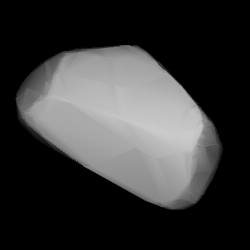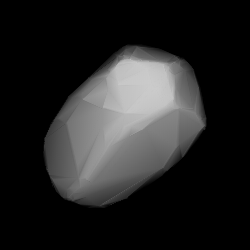Related Research Articles
51826 Kalpanachawla, provisional designation 2001 OB34, is an Eoan asteroid in the outer region of the asteroid belt, approximately 7 kilometers in diameter. It was discovered on 19 July 2001, by astronomers of the Near-Earth Asteroid Tracking program at Palomar Observatory in California, United States. The asteroid was named for Indo-American astronaut and mission specialist Kalpana Chawla, who died in the Space Shuttle Columbia disaster.

Eos is a large main-belt asteroid that was discovered by Austrian astronomer Johann Palisa on January 18, 1882, in Vienna. In 1884, it was named after Eos, the Greek goddess of the dawn, to honour the opening of a new observatory that was hoped to bring about a new dawn for Viennese astronomy.

Carolina is a sizeable Main belt asteroid. It was discovered by Austrian astronomer Johann Palisa on 28 November 1883 in Vienna, and was named after Caroline Island, now part of Kiribati in the Pacific Ocean. This asteroid is orbiting the Sun at a distance of 2.88 AU with a period of 4.89 yr and an eccentricity (ovalness) of 0.06. The orbital plane is tilted at an angle of 9.0° to the plane of the ecliptic.
Oppavia is a sizeable Main belt asteroid. It was discovered by Austrian astronomer Johann Palisa on 31 March 1886 in Vienna and was named after Opava, a town in the Czech Republic, then part of Austria-Hungary, where Palisa was born. It is orbiting the Sun at a distance of 2.75 AU with an orbital eccentricity (ovalness) of 0.077 and a period of 4.55 yr. The orbital plane is inclined by an angle of 9.47° to the plane of the ecliptic.

Florentina is an S-type (stony) main belt asteroid with a diameter of 28 km. It was discovered by Johann Palisa on 15 October 1891 in Vienna. He named the asteroid for his daughter, Florentine. Between 1874 and 1923, Palisa discovered a total of 122 asteroids.

Etheridgea is a large main belt asteroid. It was discovered by Auguste Charlois on 1 April 1892 in Nice. The meaning of the name is unknown. This asteroid is orbiting the Sun at a distance of 3.02 AU with a period of 5.26 years and an eccentricity (ovalness) of 0.10. The orbital plane is tilted at an angle of 6.05° to the plane of the ecliptic.

402 Chloë is a large main-belt asteroid. It was discovered by French astronomer Auguste Charlois on 21 March 1895 from Nice. This asteroid is orbiting the Sun at a distance of 2.56 AU with a period of 4.09 years and an eccentricity of 0.11. The orbital plane is inclined at an angle of 11.8° to the plane of the ecliptic.

Edburga is a typical Main belt asteroid. Max Wolf discovered it on 7 January 1896 at Heidelberg Observatory. The origin of the name is unknown. This asteroid is orbiting the Sun at a distance of 2.58 AU with a period of 4.15 yr and an eccentricity of 0.34. Its orbital plane is inclined at an angle of 18.7° to the plane of the ecliptic.

Iva is a main-belt asteroid orbiting the Sun, not to be confused with 1627 Ivar. It was discovered by American astronomer R. S. Dugan on 4 November 1902, and was named for Iva Shores, the young daughter of the family where he was staying in Heidelberg. This object is orbiting at a distance of 2.85 AU with a period of 4.82 yr and an eccentricity of 0.3. The orbital plane is inclined at an angle of 4.8° to the plane of the ecliptic.
678 Fredegundis is a minor planet orbiting the Sun. It was discovered 22 January 1909 from Heidelberg by German astronomer K. Wilhelm Lorenz, and was named after the French opera Frédégonde. This object is orbiting at a distance of 2.57 AU with a period of 4.13 years and an eccentricity (ovalness) of 0.22. The orbital plane is inclined at an angle of 6.1° to the plane of the ecliptic

699 Hela is a Mars crossing asteroid. It was discovered on 5 June 1910 at Heidelberg by German astronomer Joseph Helffrich, and may have been named after Hel, the Norse ruler of the underworld. This asteroid is orbiting the Sun at a distance of 2.61 AU with a period of 4.22 years and an eccentricity of 0.41. The orbital plane is inclined at an angle of 15.3° to the plane of the ecliptic.
742 Edisona is a minor planet, specifically an asteroid orbiting in the asteroid belt that was discovered by German astronomer Franz Kaiser on February 23, 1913. It was named for inventor Thomas Edison. This asteroid is orbiting 3.01 AU with a period of 5.22 years and an eccentricity of 0.119. The orbital plane is inclined at an angle of 11.2° to the plane of the ecliptic. This is a member of the dynamic Eos family of asteroids that most likely formed as the result of a collisional breakup of a parent body.
741 Botolphia is a 29.6-km diameter minor planet orbiting in the asteroid belt, discovered by American astronomer Joel Hastings Metcalf on 10 February 1913 from Winchester. It is named after Saint Botolph, the semi-legendary founder of a 7th-century monastery that would become the town of Boston, Lincolnshire, England. This asteroid is orbiting at a distance of 2.72 AU from the Sun, with an orbital period of 4.49 yr and an eccentricity (ovalness) of 0.07. The orbital plane is inclined at an angle of 8.41° to the ecliptic.
745 Mauritia is a dark background asteroid from the outer regions of the asteroid belt, approximately 24 kilometers in diameter. It was discovered on 1 March 1913, by German astronomer Franz Kaiser at the Heidelberg-Königstuhl State Observatory in Germany. The presumed carbonaceous C-type asteroid has a rotation period of 9.9 hours. It was named after Saint Maurice, patron of the Saint Mauritius church in the city of Wiesbaden, where the discoverer was born.
758 Mancunia is a minor planet orbiting the Sun. It was discovered in 1912 from Johannesburg by H. E. Wood, a Mancunian. This object is orbiting at a distance of 3.19 AU with a period of 5.70 years and an eccentricity (ovalness) of 0.15. The orbital plane is inclined at an angle of 5.61° to the plane of the ecliptic.
774 Armor is a minor planet orbiting in the main belt. It was discovered on December 13, 1913, in Paris by French astronomer Charles le Morvan and was named after the Celtic region of Armorica. The asteroid is orbiting at a distance of 3.05 AU with a period of 5.32 yr and an eccentricity of 0.169. The orbital plane is inclined by an angle of 5.56° to the plane of the ecliptic.

1767 Lampland, provisional designation 1962 RJ, is an Eoan asteroid from the outer regions of the asteroid belt, approximately 15 kilometers in diameter. It was discovered on 7 September 1962, by astronomers of the Indiana Asteroid Program at Goethe Link Observatory in Indiana, United States. The asteroid was named after American astronomer Carl Lampland.
3710 Bogoslovskij, provisionally known as 1978 RD6, is a rare-type asteroid from the central region of the asteroid belt, approximately 11 kilometers in diameter.

1220 Crocus, provisionally designated 1932 CU, is a stony Eoan asteroid and slow rotator from the outer regions of the asteroid belt, approximately 17 kilometers in diameter. It was discovered on 11 February 1932, by German astronomer Karl Reinmuth at Heidelberg Observatory in southwest Germany.
1410 Margret, provisional designation 1937 AL, is an Eoan asteroid from the outer regions of the asteroid belt, approximately 21 kilometers in diameter. It was discovered on 8 January 1937, by astronomer Karl Reinmuth at the Heidelberg Observatory in southwest Germany. The asteroid was named after Margret Braun, wife of the Heidelberg astronomer Heinrich Vogt.
References
- ↑ Noah Webster (1884) A Practical Dictionary of the English Language
- 1 2 3 "766 Moguntia (1913 SW)". JPL Small-Body Database . NASA/Jet Propulsion Laboratory . Retrieved 5 May 2016.
- 1 2 Birlan, M.; et al. (November 2007), "Spectral properties of nine M-type asteroids", Astronomy and Astrophysics, 475 (2): 747–754, Bibcode:2007A&A...475..747B, doi: 10.1051/0004-6361:20077914 .